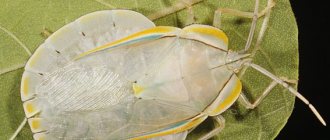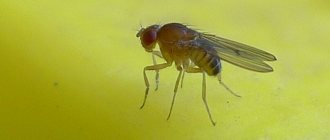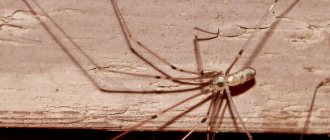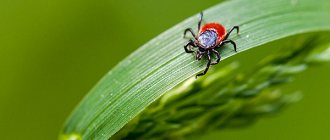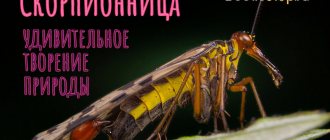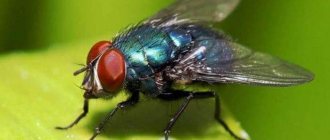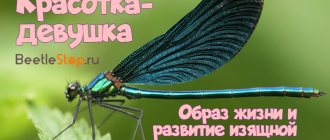Housefly (Musca domestica) is a common synanthropic insect, practically never found in the wild. Adult flies feed on a variety of solid and liquid substances of plant and animal origin. Both larvae and pupae, as well as adult females, overwinter. The housefly has many enemies: birds, reptiles, amphibians, various insects and spiders. The housefly is a dangerous carrier of many types of animal and human diseases.
Description
The entire body of the housefly is covered with sparse long hairs. The head is strongly convex in front, flat and slightly conical in back. The eyes are large, faceted (consisting of 3000 facets - miniature eyes), dark red in color. In males, the distance between the eyes is equal to 2/3 of the length of the eye, and in females it is equal to this length. Only the front pair of wings are used for flight. In the resting position, the wings are spread at a narrow angle. The hind wings are reduced and are called halteres (they are necessary to maintain the fly's balance in the air). Three pairs of walking legs. The abdomen consists of 10 segments that carry spiracles for breathing. In males, the ninth segment bears a pair of clasps for copulation, and the 10th carries the anal cerci in both sexes.
What kind of insect is this?
A fly is a two-winged insect belonging to the phylum of arthropods, the order of flies and mosquitoes. The insect's body length varies from a few millimeters to 2 cm, depending on the species.
The lifespan of flies is 1–2.5 months. One of the most important distinguishing features of the fly is its huge eyes, which consist of several thousand hexagonal lenses. Thanks to this structure of the eyes, the fly has very good vision and is able to see even what is happening from the side and behind, that is, it practically has a circular field of vision.
Nutrition
Adults feed on a variety of solid and liquid substances of plant and animal origin. The housefly's mouthparts are licking and sucking; flies are not capable of biting through the skin and drinking blood, unlike the similar autumn flies (Stomoxys calcitrans). Flies can only absorb liquid food; to consume solid food, they first dissolve it in saliva. The housefly is a polyphage. For the eggs to mature, the female needs protein food. Flies have chemoreceptors on their legs that allow the insects to identify foods, such as sugar, by walking over them. Housefly larvae have a huge appetite, especially liking meat. Tirelessly and desolately, they eat both the larvae of harmful insects and the carrion they encounter.
House fly or house fly.
The housefly is the most common type of fly that can be found in and around apartments, private houses.
This type of fly is synanthropic to humans, is rarely found outside human settlements, and is adjacent to humans. House flies are quite harmful insects that constantly scurry around the house; these pests are potential carriers of diseases.
House flies have a short lifespan of about 1.5 months, but they can multiply quickly, leading to the formation of large populations of flies if they are not eradicated in time.
The house fly is active during the day. On the street, flies prefer to hang around plants,
Enemies
The housefly has many enemies: birds, reptiles, amphibians, various insects and spiders. Eggs, larvae and pupae have many types of parasites and parasitoids. Some of the most important are the parasitic wasps Muscidifurax uniraptor and Spalangia cameroni; they lay their eggs in the tissue of housefly larvae, and their offspring complete their development before the adult flies emerge from the pupae. Chickweed beetles (Histeridae) feed on larvae in dung heaps, and the predatory mite Macrocheles muscaedomesticae consumes eggs. One tick eats 20 housefly eggs per day.
The pathogenic fungus Entomophthora muscae causes a fatal disease of house flies. Once infected, fungal hyphae grow throughout the body, killing the fly in about five days. The housefly also acts as an alternative host for the parasitic nematode Habronema muscae, which parasitizes the stomachs of horses. Salivary gland hypertrophy virus (SGHV), which causes enlargement of the salivary glands, is spread among house flies through contact with food, and infected female house flies become sterile.
Why is it necessary to control house flies?
Houseflies don't bite, but they can carry more than 100 different pathogens, including salmonellosis, cholera, typhoid fever and tuberculosis. Houseflies infest food surfaces, spreading disease-causing organisms found on their feet and mouths when feeding on garbage, feces and other decaying matter. In addition, they constantly defecate.
The house fly is a carrier of:
- cholera;
- dysentery;
- eye diseases (in particular purulent inflammation of the eyelids and trachoma);
- typhoid fever;
- tuberculosis;
- diphtheria;
- paratyphoid;
- anthrax;
- protozoan cysts;
- possible tissue and intestinal myiases (from fly larvae)
Lifestyle
The housefly leads a predominantly diurnal lifestyle. If inside buildings after dark, flies usually gather on ceilings, beams and wires, then outdoors they crawl into foliage or tall grass, or rest in bushes and trees or on wires.
Every year there are 9 to 20 generations of house flies. Both larvae and pupae, as well as adult fertilized females, overwinter. In cold rooms, flies survive the winter in an inactive state and awaken when the outside temperature is above 10°C. The flight speed is about 2.9 meters per second (about 10 km/h), while the fly flaps its wings approximately 180-330 times per second. Cold autumn and the fungus Entomophthora muscae kill most of them.
Flies regularly clean their eyes with their front paws by rubbing them together (both front and back paws). They do this because many of their taste and smell receptors are on their paws. Houseflies process visual information about seven times faster than humans, allowing them to identify and avoid attempts to catch or swat them because they effectively see human movements in slow motion at a faster rate.
Article on the topic Flies (interesting facts)
Prevention measures against house flies
- To avoid infestation by house flies, it is necessary to keep the room in order.
- It is necessary to regularly take out the trash and cover the trash can with a lid.
- Garbage cans must be removed at least once a day and be covered with lids.
- Pet waste must be thrown away
- Install mosquito nets on windows and doors
- Air curtains must be installed on doors to retail premises
- Container sites must be concreted
- Extermination measures should be carried out in the presence of flies
Reproduction and development
Females produce a pheromone that attracts males. Typically, a female mates only once (storing sperm and being able to use it across multiple clutches), while males mate multiple times with different females. Males are territorial: they defend their territory from invasion by other males and seek to mate with any female that enters this territory. A female housefly lays 70-150 white eggs, about 1.2 mm in length, at a time. During her life, the female lays six or more ovipositions (with an interval of 2-4 days). Depending on climatic conditions, a fly can lay from 600 to 2000 eggs in just its life. Under favorable conditions, flies breed all year round. Egg development takes from 8 to 50 hours. Flies are insects with complete metamorphosis. At a temperature of 16°C the larvae hatch in 46 hours, at a temperature of 19°C in 19 hours, and at a temperature of 30°C in 10 hours. One kilogram of pig manure can produce about 15,000 fly larvae.
Housefly larvae (maggots) are up to 10-12 mm long, white, legless, pointed at the side of the mouth, truncated at the back. The larvae avoid light and live in feces and other rotting semi-liquid media. Respiration occurs through cutaneous respiration and spiracles located at the end of the body. After 3-25 days and after three molts, the larva crawls to a cool, dry place and turns into a pupa. During this time, the weight of the larva increases approximately 800 times.
The pupa shell is cylindrical with rounded ends, about 1.2 mm long, formed from the last shed larval skin. At first the pupa is yellowish, darkening with age from red and brown to almost black. The pupal phase lasts two to six days at 35°C, but can take 20 days or more at 14°C. Male house flies reach sexual maturity 16 hours after birth, and females 24 hours after birth. Houseflies can breed until the air temperature drops below 15°C.
Traditional methods
Advantages of folk remedies in the fight against flies: safety for humans and accessibility. The most familiar of them is mechanical. Insects are killed using a fly swatter (or rolled up newspaper). However, this method is tedious, especially without some skill. Yes, and there are traces of dead flies on the walls. But human resourcefulness knows no bounds: some people use a vacuum cleaner turned on at full power to fight flies.
Deception
If you take into account the life activity of flies, you can trick the insects into leaving the apartment. Here are two ways.
- Ventilation. Since the vital functions of winged pests “turn on” when the temperature rises above 15°C, you can thoroughly ventilate the apartment to force the “enemy” to leave the house.
- Blackout. Flies fly, which means they have the opportunity to get food only when it is light. Twilight forces insects to look for a more “friendly” habitat.
Flies are afraid of drafts, but at the same time they may not leave the apartment, but simply sit out in secluded corners. As soon as the windows are closed, the insects will make themselves known again.
"Aromatherapy"
There are odors that are extremely uncomfortable for flies. Diptera prefer to leave places that emit unpleasant odors. Here are three ways to help get rid of insects.
- Ethers. Do general cleaning using a solution of essential oils (two to three drops per liter of water) to wash walls, floors and cabinets. Flies cannot stand the smell of cloves, citronella, peppermint, eucalyptus, and lemongrass.
- Alcohol. Using a spray bottle, spray vodka in the room where the flies live.
- Seasonings. Grind a handful of dry clove buds in your palms and place in a vase or any bowl.
Insects do not like the smells of some plants. Therefore, it is useful to “settle” geraniums on the windowsill. It’s nice to have a pot of peppermint or basil at home: their leaves can also be used as aromatic seasonings. For those who are far from floriculture, there is also a way: hang “bouquets” of dried tansy, bay leaves, lavender or wormwood indoors.
To prevent flies from ruining your summer dinner on the veranda or in the gazebo, you can make a simple insect repeller. Cut a lemon in half, stick a few cloves into each part and place on the table.
Traps
To make a fly trap, you need to pour water or milk sweetened with sugar, honey or jam into a small jar. Fold a sheet of paper into a funnel shape and place it on the container with the base facing up so that it does not touch the solution. The flies will fly into the jar, but will not be able to get out. Here are two more ideas for indoor fly traps.
- Vinegar. Pour vinegar mixed with a small amount of dishwashing liquid into a small container, cover the container with a plastic bag, after making several holes in it.
- Sugar ribbon. Prepare a strong sugar solution, add honey or jam syrup. Cut strips of craft paper and soak in the mixture for several hours. Take it out, dry it, hang it in places where insects gather.
Poisonous mixtures
Flies can be poisoned. To do this, you need to prepare a poisonous mixture with an odor attractive to pests, pour it into saucers and place it in places where arthropods accumulate. Here are three options.
- Pepper mixture. Add hot pepper or ground black pepper to the sugar solution. After feasting on such a mixture, the insect will die in three to four days. This composition is more preferable, since it is safe for humans and animals.
- With formaldehyde. Combine water (125 ml) with milk and formalin (25 ml each) or dilute 30 ml of formalin in 40 ml of glycerin. Such mixtures are toxic to people and animals, so they should not be used in a home where there are children and pets.
- With saccharin. Combine honey and saccharin, soak a sheet of newspaper in the resulting mixture, and dry the paper. Place the workpiece on a plate and sprinkle with water.
Saving flowers
Indoor plants can become habitats for fruit flies. Three folk methods will help you get rid of flies in flowers. After using them, you need to wash the pots and trays with a solution of laundry soap or vinegar.
- Garlic irrigation. Finely chop the head of garlic and pour 600 ml of boiling water over the raw material, leave for three to four hours and pour the mixture over the indoor plants.
- Orange therapy. Place orange zest in flower pots.
- Soap spraying. Stir 20 g of grated laundry soap in a liter of warm water. Spray the plant with the solution.
Ways to fight
Musca domestica is a carrier of pathogens of dangerous intestinal infections (typhoid, cholera, etc.), and worm eggs. On the body of each insect that has been in the waste, 5 million bacteria remain, and in its digestive system - over 25 million. Summer is the period when the winged species spreads, so outbreaks of epidemics become more active.
Diseases carried by flies can have completely different types and degrees of danger to humans.
Population increases are easy to prevent. The premises are kept clean and garbage is disposed of daily. The smell of rotting waste attracts adults and provides an excellent breeding ground. In the spring, mosquito nets are installed on the windows, and sticky trap tapes are hung in the rooms.
Cesspools and street toilets are treated with disinfectants once a month. Places with containers must be paved. If there are a lot of insects, then more aggressive methods will help:
- Chemistry . Poisonous spray Dichlorvos and Chlorophos paste are proven insecticides that quickly destroy livestock.
- Vinegar . Acid is poured into a jar and a teaspoon of detergent is added. Cover the container with film and make a small hole. Attracted by the smell, individuals enter the hole, but cannot get out and drown in the liquid.
- Plants. The creatures do not like the aroma of tansy, toadflax and castor beans. Crops are planted near the house or bouquets of them are hung indoors.
Try in every possible way to prevent the reproduction of flies in order to avoid a number of troubles
In advanced cases, it is better to seek help from professional services. The longer you wait, the more the parasite spreads throughout the area. During its short life cycle, one pair is capable of reproducing offspring whose total weight is more than 50 tons.
The housefly is an annoying insect that has been living near humans for a long time. Dangerous carriers of intestinal infections have perfectly adapted to the domestic climate. To effectively fight the creature, it is important to understand what the species likes and how it reproduces.
This is interesting: the housefly.
Notes
- Mamaev B. M. Order Diptera, or Flies and Mosquitoes (Diptera) // Animal Life. Volume 3. Arthropods: trilobites, chelicerates, trachea-breathers. Onychophora / ed. M. S. Gilyarova, F. N. Pravdina, ch. ed. V. E. Sokolov. — 2nd ed. - M.: Education, 1984. - P. 411. - 463 p.
- Stackelberg A. A., Breev K. A. [bse.sci-lib.com/article063477.html Housefly] // Great Soviet Encyclopedia. — 1969—1978.
- Derbeneva-Ukhova V.P. Synanthropic flies // In the book: Guide to medical entomology. M.: Medicine, 1974, pp. 176-203
Ktyri
Slender, predatory flies are quite large in size. The body and limbs are covered with a thick layer of short hairs. For humans, blackflies do not pose any danger, but insects such as mosquitoes, midges, beetles and even bees are quite rightly
they are afraid.
Ktyrs obtain food by hunting in the air, clutching the caught prey with their tenacious long paws. After this, they stick their sting into the defenseless body to inject poison into it and calmly suck out the contents. Sometimes another ktyr can become the prey of a ktyr.
This predatory fly brings great benefits to humanity, killing and eating many different dangerous insects. The larvae of moths are also predators. They live in rotten wood, soil and other rotting matter, where their food is various small insects and other larvae.
Horsefly
But blood-sucking horse flies attack humans and livestock very actively, often in large numbers. Their bites are very painful, and the bite site swells greatly due to saliva and anticoagulants injected under the skin (and the latter also contribute to prolonged bleeding from the wound).
And this is not just an unpleasant process - horsefly bites transmit many dangerous diseases to humans and livestock, from anthrax and tick-borne encephalitis to tularemia, listeriosis, dermatitis and allergies.
Externally, the horsefly is not difficult to identify - it is a large (up to 3 cm long) two-winged insect with a dark, sometimes striped, flattened body and huge eyes. They fly very quickly and can actively attack people, especially in the hottest part of the day and when the skin is moistened with water or sweat - during swimming, physical work in the air, or simply when being near bodies of water.
Links
- [bse.sci-lib.com/article063477.html Housefly] in TSB
- [creatures.ifas.ufl.edu/urban/flies/house_fly.htm Housefly] on the website of the University of Florida Institute of Food and Agricultural Sciences (English)
- [www.ncbi.nlm.nih.gov/entrez/query.fcgi?cmd=Retrieve&db=pubmed&dopt=Abstract&list_uids=11902690&query_hl=1 Dübendorfer A, Hediger M, Burghardt G, Bopp D. Musca domestica, a window on the evolution of sex -determining mechanisms in insects. Int J Dev Biol. 2002, 46(1):75-9.] (English)
- [scholar.google.com/url?sa=U&q=taylorandfrancis.metapress.com/index/0HWHMF75LPPG7YP6.pdf Brian M. Wiegmann, David K. Yeates, Jeffrey L. Thorne, Hirohisa Kishino Time Flies, a New Molecular Time-Scale for Brachyceran Fly Evolution Without a Clock. Systematic Biology. 2003, 52(6):745-756] (English)
Aerodynamic properties
The flight of a fly is a unique phenomenon, the nature of which scientists still cannot fully understand. Insects move quickly, have excellent maneuverability, and change direction almost instantly.
Flight Features
The flight of a fly has several features:
- acceleration is not required for takeoff;
- hovering in the air;
- sudden change in trajectory;
- covering long distances without reducing speed;
- hard landing.
A fly can change direction many times in flight without slowing down at all. Most often they fly in zigzags.
Height
Usually flies do not need to rise high, because they mainly find food on the ground. But flies fly at a height of 7–10 floors, and if necessary they can rise higher. How high the fly rises is greatly influenced by the speed and direction of the wind.
Range and speed
The average speed of a fly is about 3 km/h, but if necessary, the insect can fly at speeds of more than 6 km/h. The flight speed of a fly depends on its size, how hungry it is, and how strong the reproductive instinct is.
But scientists have not yet been able to find out how many kilometers a fly can fly without resting. After all, usually the movement of a fly is limited to covering a short distance, after which it lands.
Flying in the rain
If you have to fly during the rain, most often the insect will not be harmed and, moreover, will remain dry. It's all about the visual characteristics of these insects, as well as the speed of reaction.
In flight
Attention! A fly in flight sees all the drops approaching it and can maneuver to avoid them.
Gadfly
Yes, gadflies also belong to synanthropic flies, although many, due to their “fluffiness,” are more reminiscent of bees or bumblebees.
These are large (up to 3 cm in length) insects with a gray or yellowish, sometimes striped body, abundantly covered with hairs.
Gadflies in our latitudes do not attack or bite humans. They are dangerous parasites of large animals - a person can suffer from these insects only if the eggs of the gadfly somehow get on his mucous membrane or under the skin. But if a female gadfly decides to pierce your skin to lay larvae, you will notice this by large swelling and redness, as well as severe itching. Botfly larvae can also cause myiasis.
- 7 dangerous insects that lie in wait for us in the country and beyond
Rating of insects, after bites of which you need to urgently take safety measures.
Head structure
The individual parts of the fly's head have their own names:
- forehead - located between the eyes, at the top it turns into the crown, at the bottom of it there are antennae;
- the fly's face is located below the whiskers and looks like a facial plate bounded by the forehead and frontogenal suture;
- there are cheeks under the eyes;
- the back surface of the head is convex or flat (in some species it is concave);
- the eyes are convex faceted, formed from many facets; in males and females the facets are different - in the former they are holaptic and very close together; eye color varies between species;
- in the oral cavity there is a proboscis instead of the lower lip with sucking lobules at the end, here the salivary gland channel passes;
- The fly's jaws (upper and 1 pair of lower) are atrophied.
The organs of smell and taste are much more advanced and subtle compared to humans. The sharpness and their cricketing ability are associated with a large number of “nostrils,” although the olfactory organs are separated from the respiratory organs and are located on the antennae; some species of dipterans also sense taste with their paws, or rather, with their last segments on the legs.
Ilnitsa-beeweed (tenacious Ilnitsa)
This type of fly belongs to the hoverfly family. In appearance they are similar to an ordinary bee. The average length is 1.5 cm. The abdomen is dark brown in color, covered with plumage of small hairs; on the side there are large red spots with a yellowish tint. In the middle part of the fly's face there is a wide, well-developed shiny black stripe. Before our eyes - two
vertical stripes with thick hair. The hind limbs in the lower leg area are also covered with hairs. The insect's thighs are almost black.
The larva of the bee moth is dark with a gray tint. The body of the larvae has a cylindrical shape and reaches a length of 10–20 mm. The larva breathes using a special breathing tube, which can stretch up to 100 mm in length. This organ is very important for her, since she lives in conditions of fetid liquids, garbage pits and pond sewage, and can only breathe clean air.
This insect is active from July to October. Illices feed on the nectar of various flowering plants.
Beeworm larvae can be the source of a dangerous intestinal disease found in some European countries, Africa, Australia, Chile, Argentina, India, Iran and Brazil.
The disease occurs as a result of fly eggs entering the human intestines along with food. There the larva hatches and begins to develop, causing enteritis.
Ktyr
These flies, strictly speaking, have little interest in humans. Ktyri are active and aggressive hunters of insects. But, if touched or caught, they will definitely bite a person. The saliva of moths contains a strong poison, from which the insects caught by it die instantly, and a person develops painful swelling.
Eggs are laid on wood or grass, and the larvae feed on decaying organic debris.
How to identify a bird? They have large eyes and a slender, often elongated and usually short, densely pubescent, orange-yellow body. The sizes of the ktyres are very different, from 3 to 50 mm.
